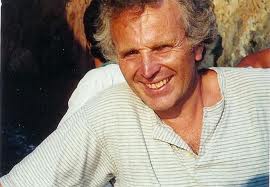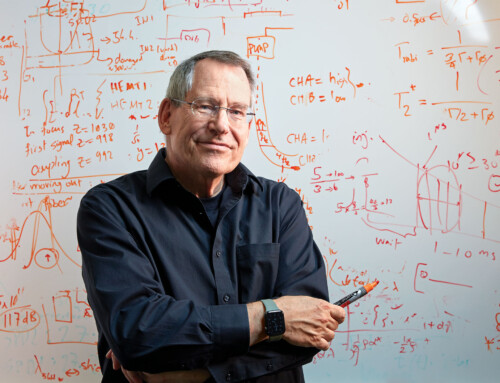Rushing to produce a congratulatory post for Stephen Hawking yesterday, I didn’t mention the other big news regarding the Fundamental Physics Prize. Joe Polchinski, Sasha Polyakov, Charlie Kane, Laurens Molenkamp, and Shoucheng Zhang have received the 2013 Physics Frontiers Prize, making them eligible for the Fundamental Physics Prize to be announced on March 20. The New Horizon in Physics Prize (for young physicists) has been awarded to Niklas Beisert, Davide Gaiotto, and Zohar Komargodski. And another “special” $3M Prize, shared by seven people, appropriately recognizes the discovery of the Higgs boson.
The selection committee did a good job.

Joe Polchinski
Joe Polchinski was a Caltech undergrad, class of 1975 (before my time here). I first met Joe in 1982 when he arrived as a postdoc at Harvard, where I was then on the faculty, and it did not take long for me to recognize his genius. I was teaching a course that fall on advanced quantum field theory, and Joe sat in, at least for a while. One of my lectures was about renormalizability, and I talked about how the renormalization group can organize and simplify the horrible combinatoric task of taming the overlapping divergences in Feynman diagrams to all orders of perturbation theory. I had learned this idea from Curt Callan‘s wonderful 1975 Les Houches Summer School Lectures.
My lecture may have provided the impetus for Joe to put this claim on a firm foundation, and the result was an argument far more beautiful than what I had gleaned from Callan. Joe had the insight to base his argument on the seminal ideas of Ken Wilson, that great fount of renormalization group wisdom. In his paper, which became very famous, Joe thanked me “for inspiration,” an acknowledgment that I treasure. Looking back, though, considering how quickly he constructed the argument, I suspect that Joe had worked out most of it a while earlier.
As a great master of quantum field theory and string theory, Joe has left his mark on a broad swath of contemporary physics. Twenty years ago, gossiping theorists might have whispered that Joe had not made any discovery commensurate with his extraordinary talent, but that changed in 1995 when he discovered the fundamental role of D-branes in string theory. Most of the subsequent advances in string theory, including the counting of black hole microstates and the AdS/CFT correspondence, have built on that foundation.

Sasha Polyakov
I have never gotten to know Sasha Polyakov well, but like all theoretical physicists of my generation I hold him in awe. When I was a graduate student in the late 1970s, there were two great physicists who seemed to be leading most of the great advances in quantum field theory: Polyakov and Gerard ‘t Hooft. (I assume that the Milner Committee shied away from ‘t Hooft because he has already received a Nobel Prize.) What those two achieved in the 70s and early 80s is truly astonishing.
There are close parallels in the work of ‘t Hooft and Polyakov. They independently discovered that magnetic monopoles arise as solitons in spontaneously broken gauge theories. Both made fundamental contributions to our understanding of the role of quantum tunneling (“instantons“) in quantum field theory, and recognized that quark confinement hinges on the topology of gauge fields. Aside from all that, Polyakov launched the path integral approach to string theory in non-critical dimensions, and laid out the formalism of two-dimensional conformal field theory, a contribution just as seminal in condensed matter physics as in particle theory.
I first heard Polyakov speak during his visit to Harvard in 1978, and his talk, mostly about Z2 gauge theory, was memorable for a number of reasons. He was the first Russian I had seen wearing blue jeans. And he made a pronouncement so striking that I wrote it in my notebook, inside quotes: “QCD must be exactly soluble, or else I cannot imagine what the physics textbooks of the future will look like.” I pondered that statement, and the rest of the lecture, for months afterwards. Though it took 20 years, in a sense this prediction proved true, at least when “QCD” has enough supersymmetry and enough colors.
It’s terrific that the nominees include Kane, Molenkamp and Zhang, as the discovery of topological insulators has been among the most exciting developments in condensed matter physics in recent decades. Like particle theory, condensed matter theory has a highly mathematical side and a highly phenomenological side. But more often than in contemporary particle theory, a theorist can tie the two sides together. Kane and Zhang did that, by not only conceiving topological insulators, but also proposing materials in which the phenomenon could be realized, thus guiding the experimentalists.
As I understand it, there are three candidates for the 2013 Fundamental Physics Prize, where the team of Kane-Molenkamp-Zhang is considered to be one candidate. All are very deserving. We’ll have to wait until March 20 to know the winner; the other two will remain eligible for five years, and will receive a $300,000 award this year.
I’m putting my money on Polyakov for this year’s Prize. His contributions are just too deep and extensive to pass up. But I’ll be happy no matter how it turns out.



